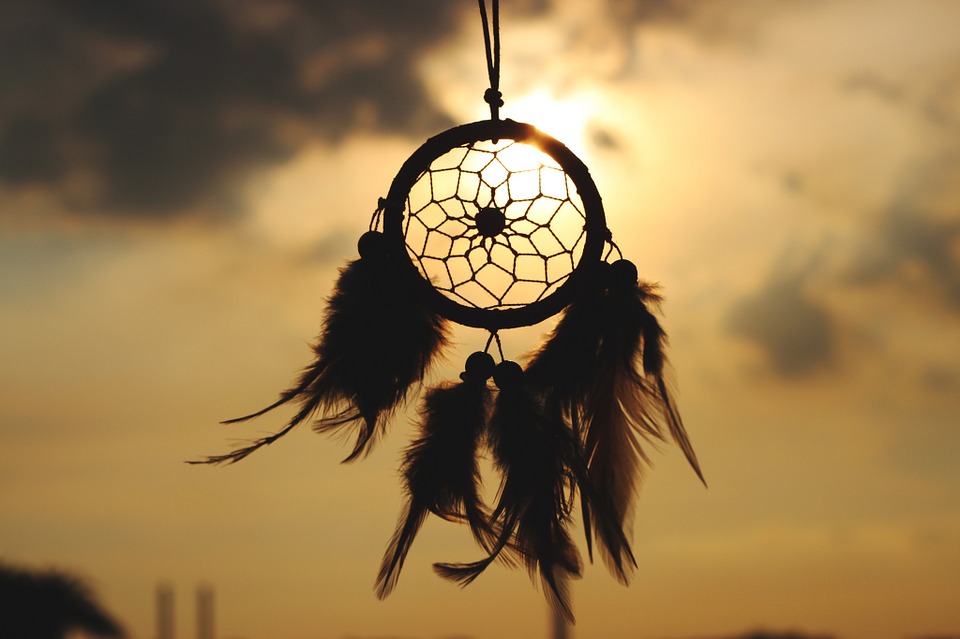
Dreamcatchers, if you hadn’t noticed by now, are one of the most popular spiritual decorations with a strong background story, and there are many, many variations on the traditional structure of hoop, twine or sinew, feathers, shells, etc.
What people might not know specifically about the Native American dreamcatcher is the actual story behind the structure.
One Structure, Many Legends
The basic idea behind the dreamcatcher goes thusly: good dreams know how to get through the web, they slide down the feathers and to the person dreaming. The bad dreams get caught in the web, and disappear with the morning sun.
It’s somewhat difficult to pinpoint which tribe was the exact originator of the dreamcatcher, as many tribes across the US have very similar stories surrounding the item, the most prominent legends coming from the Ojibway, Lakotas and Cherokee. Each has their own variation, featuring different names, characters, and events.
Construction And Appearance
The basic construction of the dreamcatcher is similar across many tribes, and the elements of a traditional dreamcatcher are usually all natural, and if you are sensitive to energies, you can sense the true power, the true intention within the dreamcatchers with all-natural elements. You know by feeling that such a dreamcatcher is not just a pretty thing for decoration. It’s a tool for protection and an aide to true dreaming, as it’s commonly thought throughout many Native tribes that dreams are important guides for your life.
The dreamcatchers you might see in stores that are a bit fancier-looking might have some natural elements, but might have other parts that are man-made. These are dreamcatchers made solely for looks. There’s not a lot of real power and intention to them. Also, traditionally, size does matter—on the smaller side of things, that is.
As amazing and beautiful as large dreamcatchers are to look at, such creations are usually not made by Natives. Most traditionally sized dreamcatchers are no bigger in diameter than the average adult’s hand.
Other Interesting Facts About Dreamcatchers
While traditional dreamcatchers have feathers on them, usually, the US govermment made it illegal to use feathers from predatory birds such as eagles, hawks, etc. So the Natives who make dreamcatchers will often ask the Creator and Mother Earth to be shown feathers for the purpose of making a dreamcatcher, and make offerings in return for those feathers, as well as any other items they might gather from Mother Earth.
Additionally, because certain feathers are verboten, Native tribes started added semi-precious beads to dreamcatchers to stand in for what would ordinarily have been used. You’ll also often see the traditional colours of red, yellow, black and white in many dreamcatcher colour schemes because these colours represent the four ‘tribes’ or ‘races’ of humanity: red, for the First Nations, black for the Africans, yellow for the Asian peoples, and white for European/Caucasians.
Other symbology of the dreamcatcher:
- Hoop/Circle. It represents the great hoop of life that connects us all. Usually made of wood as a gift from the Standing People (trees).
- Webbing. This represents the gift of Grandmother Spider’s web to help catch the bad dreams.
- Feathers. Gift from the Bird People. Symbolises the communication of dreams from Great Spirit to us humans, and an aid to dispel bad spirits.
- Beads. Traditionally, only one bead is placed in the webbed area of the dreamcatcher, to represent the One Creator, though other tribes may use other additional beads, but oft-times, no more than four.
- Leather. Represents the gift from the four-leggeds, usually deer.
- Shells. If used, shells represent those that live in the seas.
Additionally, it is thought, even by Native Americans, that there really is no such thing as a ‘bad’ dream. Even nightmares can be considered good, especially if they serve as warnings to the dreamer to change their life, their actions, etc. So what kind of dreams might be considered ‘bad’? Usually, they’re the less important dreams, the ones we have when the brain is simply sorting out day-to-day stuff.
Dreamcatchers, usually hung above the bed, are an ideal addition to a mystic’s spiritual practise, particularly if you believe that dreams are messages from the Divine and are worth paying attention to.
